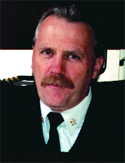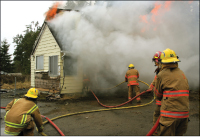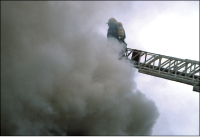
Features
Structural
Training
Trainer’s Corner: The science of reading smoke
Smoke, heat and toxic gases are all products of combustion. They are produced during a fire’s normal progression and growth. If the fire is inside a structure, the compartment acts as a container, trapping these products of combustion. These trapped products of combustion can cause reduced visability, rapid fire spread and, in some cases, can create a potential for explosion. Smoke, heat and toxic gases are all products of combustion. They are produced during a fire’s normal progression and growth. If the fire is inside a structure, the compartment acts as a container, trapping these products of combustion.
June 6, 2008
By Ed Brouwer
 Smoke, heat and toxic gases are all products of combustion. They are produced during a fire’s normal progression and growth. If the fire is inside a structure, the compartment acts as a container, trapping these products of combustion. These trapped products of combustion can cause reduced visability, rapid fire spread and, in some cases, can create a potential for explosion.
Smoke, heat and toxic gases are all products of combustion. They are produced during a fire’s normal progression and growth. If the fire is inside a structure, the compartment acts as a container, trapping these products of combustion. These trapped products of combustion can cause reduced visability, rapid fire spread and, in some cases, can create a potential for explosion.
Convection is the primary principle that controls the spread of smoke, heat and toxic gases within a compartment. Heated gases expand, becoming less dense than cooler gases. As a result, the hot gases produced by a fire in a closed room rise to the ceiling (thermal layer) and spread outward, displacing cooler air and pushing it toward the floor. Smoke, heat and toxic gases will spread horizontally along the ceiling until they find an opening that allows them to reach a higher level. They will then flow upward through the vertical opening until they reach another horizontal obstruction. At that point, they will again spread out horizontally and bank down as they accumulate. This process is called mushrooming.
 |
| Colour, location and amount of smoke can provide valuable clues to the fire’s size, intensity and fuel. |

|
The majority of gases produced by a fire, most notably carbon monoxide, are toxic. These gases pose a life-threatening condition. Whether interior or exterior attack, mop-up or exposure protection, a structure or vehicle fire, fighfighters should use full PPE.
Because smoke is the direct result of fire, it is generally hot when created. The inhalation of superheated gases in smoke can cause severe burns to the respiratory tract. Hydrogen cyanide is formed when plastic products, such as the PVC pipe used in residential construction, burn. It is a poisonous gas that is quickly absorbed by the blood and interferes with cellular respiration. Phosgene gas is formed from incomplete combustion of many common household products, including vinyl materials.
Convection, the flow of heated gases produced by the fire, is one of the primary mechanisms of fire spread. The gases may be hot enough to ignite combustible materials along their path. In addition to igniting combustible materials, the hot gases, smoke and other products of combustion can explode.
In many cases, these products of combustion may include a rich supply of partially burned fuels that are hot enough to ignite but lack sufficient oxygen to support combustion. If these products are mixed with fresh air, the atmosphere itself can ignite or, in an extreme situation, explode.
Try this simple experiment. Light a candle (an emergency candle works best). Let it burn for at least two minutes. Now, light a match and then, as you blow out the candle, bring the lighted match close to the white smoke trailing from the wick. You should see the white smoke ignite and jump the flame back onto the wick. This proves there is enough unburned fuel (gas) in the smoke to ignite. You may not think this is a big a deal but consider this same experiment with 100 times the smoke volume. (See sidebar, below.)
SMOKE EXPLOSION Following is a brief description of a smoke explosion according to Paul Grimwood at firetactics.com : ■ A smoke explosion can involve cold smoke; ■ A smoke explosion involves a contained layer of flammable smoke already existing within its limits of flammability; ■ All that is needed is an ignition source; ■ A rich-mix of superheated fire gases in smoke may auto-ignite'; ■ All that is needed in this case is AIR – this is not truly reflective of a smoke explosion; ■ A smoke explosion usually causes structural damage caused by pressure waves whereas the lesser event, termed flash fire, does not; ■ When a flashover occurs, there is generally plenty of smoke accompanying it; ■ Smoke explosions usually occur with smoke/gas/air pre-mix below 650 C for if the temperature is higher than this the gases will most likely auto-ignite. |
Typically, firefighters view smoke as light or heavy. This may be adequate for an initial size up report but it is not descriptive enough when trying to discover what is going on with a fire. The colour, location and amount of smoke can provide valuable clues to the fire’s size, intensity and fuel.
Thin, light-coloured smoke moving lazily out of the building usually indicates a small fire involving ordinary combustibles. Thick, dark grey smoke “pushing” out of a structure, suggests a larger, more intense fire. A fire involving petroleum products will produce large quantities of black, rolling smoke that rises in a vertical column.
Smoke movement is a good indicator of the fire’s temperature. A very hot fire will produce smoke that moves quickly, rolling and forcing its way out through an opening. The hotter the fire, the faster the smoke will move. Cooler smoke moves more slowly and gently. On a cool, damp day with very little wind, this type of smoke might hang low to the ground (smoke inversion).
The four attributes of smoke – volume, velocity, density and colour – must be analyzed.
Smoke volume is an indicator of the amount of fuels that are off gassing within a given space. In itself, smoke volume tells very little about the fire.
The speed at which smoke leaves a building is referred to as velocity. Smoke velocity is an indicator of pressure that has built up within the compartment.
Smoke movement caused by heat (convection) will typically rise and slow gradually after it leaves the building. If the velocity of smoke leaving an opening is agitated or turbulent, then rapid fire progress is likely to occur. In these cases, the structure must be ventilated and cooled.
The NFPA definition for backdraft is the explosive or rapid burning of heated gases that occurs when oxygen is introduced into a building that has not been properly ventilated and has a depleted supply of oxygen due to fire. (Burklin, NFPA 1980)
More than half of the indicators warning of potential backdraft have to do with smoke: smoke puffing at intervals from the building (appearance of breathing); pressurized smoke coming from small cracks; black smoke becoming dense, grey yellow smoke-stained windows.
Incomplete burning causes smoke density (smoke thickness). The greater the smoke density the more likely a hostile fire event, such as flashover or rapid fire spread, can occur. In essence, the thicker the smoke, the more spectacular the flashover or fire spread.
For single-fuel fires, smoke colour may indicate the type of material burning. In typical residential and commercial fires, it is rare that a single fuel source is emitting smoke. Smoke colour can, however, tell the firefighter what stage of burning is taking place or where the fire is within a building.
Virtually all solid materials will emit a white smoke when first heated. This white smoke is actually moisture. As the material dries out and breaks down, the colour of the smoke will change. Natural materials will change to tan or brown while plastics and painted surfaces will turn to grey. Grey is a result of moisture and hydrocarbons (black) mixing. All materials will eventually off gas a black smoke; flame contact will cause materials to give off black smoke right away.
Smoke velocity and colour differences from opening to opening help firefighters find the location of the fire. Faster/darker smoke is closer to the seat of the fire; slower/lighter smoke is farther away. If smoke from multiple openings is a constant colour and velocity, firefighters should start thinking that the fire is deep seated within the structure.
Black fire is a phrase used to describe smoke that is of high volume, turbulent velocity, ultra-dense and black. Black fire is a sure sign of impending auto-ignition and flashover. Be advised: wind, thermal balance, fire streams, ventilation openings and sprinkler systems can change the appearance of smoke, causing a false reading.
I have heard more then a dozen testimonials from incident commanderss who, after correctly reading the smoke, called for an evacuation of the burning structure, no doubt saving the lives of their firefighters.
Ed Brouwer is the chief instructor for Canwest Fire in Osoyoos, B.C.,
and the training officer for West Boundary Highway Rescue. The 18-year
veteran of the fire service is also a fire warden with the B.C.
Ministry of Forests, a first responder, level III, instructor/evaluator
and fire-service chaplan. E-mail: ed@thefire.ca
Print this page
Advertisement
- Flashpoint: No more mister nice guy (apologies to Alice Cooper)
- Truck Checks: Transmission Tips – Part 3